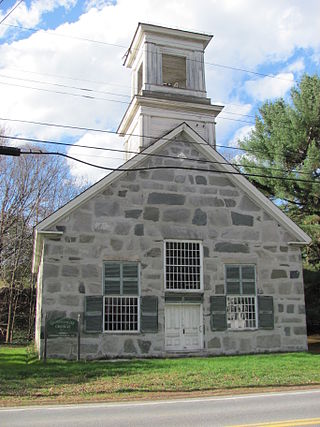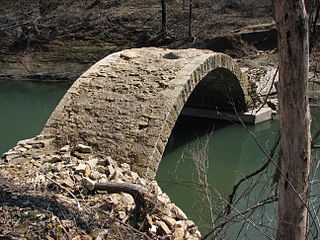
The Hope Memorial Bridge is a 4,490-foot-long (1,370 m) art deco truss bridge crossing the Cuyahoga River in Cleveland, Ohio. The bridge connects Lorain Avenue on Cleveland's west side and Carnegie Avenue on the east side, terminating just short of Progressive Field.

The Campbell-Christie House is a historic home that has been relocated to New Bridge Landing in River Edge, Bergen County, New Jersey. It was added to the National Register of Historic Places on January 10, 1983, as part of the Early Stone Houses of Bergen County Multiple Property Submission (MPS).

Cavendish Universalist Church is a historic church building on Vermont Route 131 in Cavendish, Vermont. It was built in 1844 by Scottish immigrant stonemasons, using a "snecked" ashlar stone finish that is rare in the state outside the immediate area. The building was added to the National Register of Historic Places in 1973.

The Alex Halone House in Thermopolis, Wyoming, United States, was built by Finnish immigrant Alex Halone for his personal residence in 1909–1910. Halone, a stonemason, built several stone structures in Thermopolis. Three generations of the Halone family were stonemasons. The grounds include a log Finnish sauna built by Alex and Eugene Halone with assistance from Lauri Suikaonen in 1946–51.

The E. E. Burdick House, at 248 Prospect St. in Tonopah, Nevada, United States, was built in 1906. It has also been known as St. Marks P.E. Church Parsonage. It was listed on the National Register of Historic Places in 1982.

The Sixth, Seventh, and Tenth Street Stone Arch Bridges are three stone arch bridges in Charleston, Illinois, which carry Sixth, Seventh, and Tenth Streets across the Town Branch of Cassell Creek. Prominent local stonemason Alexander Briggs built the three bridges during the 1890s, when increasing development in Charleston expanded across the creek. The three bridges were all built from locally quarried limestone, and each has a single arch design with abutments at both ends. While Charleston has thirteen bridges across the Town Branch, these three are the only stone arch bridges in the city.
The Keel Creek Bridge is a bridge on Oklahoma State Highway 31 seven miles northeast of Coalgate, Oklahoma. The bridge is listed on the National Register of Historic Places. It was constructed as a Works Progress Administration project. The bridge is significant because of its importance to the transportation history of the area and because it is a WPA-built structure.

Bridge No. L1409, also known as the Garvin Brook Bridge, was a historic stone arch bridge in Hillsdale Township, Minnesota, United States, built in 1895. However it was largely destroyed during the 2007 Midwest flooding, when runoff carried away everything except the arch substructure. It had been listed on the National Register of Historic Places in 1990 for having state-level significance in the theme of engineering. It was nominated for being Minnesota's "most impressive" rural stone arch bridge, owing to its fine ashlar masonry and sizeable 45-foot (14 m) span. The bridge has been replaced by a modern structure. It was officially delisted from the National Register in 2016.

The Sacketts Brook Stone Arch Bridge, also known locally as the Hi-Lo Biddy Stone Arch Bridge, is a historic bridge just outside the village of Putney, Vermont. It is a stone arch bridge that formerly carried Mill Street across Sacketts Brook, about 0.25 miles (0.40 km) east of United States Route 5. It was built in 1906 by James Otis Follett, an area stonemason, and is one of a few surviving examples of his work. The bridge was listed on the National Register of Historic Places in 1976.
The Thomas Slye House is a historic residence located north of Andrew, Iowa, United States. It is one of over 217 limestone structures in Jackson County from the mid-19th century, of which 101 are houses. The Slye house features a five bay symmetrical facade capped by a gable roof. Slye, a native of England, quarried the stones for the house himself and had a stonemason construct the house. The stones are of various sizes and shapes and laid in courses. The double end chimneys are found on only two other stone houses in the county, and the Slye and DeFries houses have them constructed in brick. Also similar to the DeFries House is the use of jack arches instead on lintels above the windows and doors. It is possible that both houses were constructed by the same stonemason. A single-story frame addition with an attached two-car garage was built onto the back of the houses at a later date. The house was listed on the National Register of Historic Places in 1992.

The Insane Asylum at the County Poor Farm is a historic building located north of Andrew, Iowa, United States. It is one of over 217 limestone structures in Jackson County from the mid-19th century.
The Gilliece Bridge was a historic structure located west of Bluffton, Iowa, United States. It spanned the Upper Iowa River for 151 feet (46 m). In 1872 Winneshiek County started to replace its older short span timber and stone bridges. This Bowstring through arch-truss bridge was designed, fabricated, and built by the Wrought Iron Bridge Company of Canton, Ohio in 1874 for $6,969.47. Thomas Dwyer, a local stonemason, built the masonry abutments. The bridge was listed on the National Register of Historic Places in 1998. The bridge was destroyed in May 2017 by an overweight truck which was driven onto it despite the posted weight limit of three tons.

The Steyer Bridge is a historic structure located on the west side of Decorah, Iowa, United States. This is one of the few stone arch bridges that continue to exist in Iowa. It was constructed by local stonemason Michael Steyer over Twin Springs Creek in 1875. Steyer emigrated from Germany in 1867, and settled in Decorah. His brother Joseph was the proprietor of the Steyer Opera House in town. Compared to other stone bridges in the state, this one is less sophisticated and is a good example of vernacular engineering. It is a small structure that consists of a single arch that is formed by rough-cut limestone voussoirs. The keystone is a block of dressed limestone with Steyer's name and the date "1875" carved on it. The spandrels and the walls that form the foundation for the approaches to the bridge consist of coursed rubble limestone. The base of the walls and the lower edges of the arch were reinforced with concrete in the 1970s. The concrete bridge deck is edged with wooden posts. When U.S. Route 52 was relocated to this area in the early 1970s, the Steyer Bridge was scheduled to be removed, but local protests saved it and the highway bridge built over it. The bridge listed on the National Register of Historic Places in 1983.

The Kedron Brook Bridge is a historic stone arch bridge, carrying Densmore Hill Road across Kedron Brook in southern Woodstock, Vermont. Built about 1810, it is one of the state's older stone bridges, built from locally gathered stone. It was listed on the National Register of Historic Places in 1992.
The Sprague, Brown, and Knowlton Store is a historic building located in Winterset, Iowa, United States. Built in 1866 to house a dry goods store, it is an early example of a vernacular limestone commercial building. The two-story structure is composed of locally quarried ashlar and rubble stone. It features chamfered quoins and jambs, and a bracketed stone cornice. Its construction has been attributed to local stonemason David Harris. The storefront has subsequently been altered. The building was individually listed on the National Register of Historic Places in 1987, and it was included as a contributing property in the Winterset Courthouse Square Commercial Historic District in 2015.
The Garnavillo Township Bridge is a historic structure located west of Garnavillo, Iowa, United States. It spans an unnamed stream for 20 feet (6.1 m). Around the turn of the 20th-century Clayton County embarked on a project to replace its old bridges. On short crossing like this one they generally chose simple timber stringer structures. But for this one, and several others, they chose to take advantage of the large limestone deposits in the county. They contracted with stonemason A.C. Boyle of McGregor, Iowa to build this single deck arch bridge for $1,462.72. It replaced an old combination truss span. This bridge also been replaced, but it remains in place underneath the newer bridge. It was listed on the National Register of Historic Places in 1998.
The Diamond A Ranch, or Spring Ranch, is a ranch in the upper Wind River valley of Fremont County, Wyoming. The site was first settled by John Robert McDonald, a Scottish immigrant who had a 160-acre (65 ha) homestead on the site in 1891. McDonald sold the property to John Williamson in 1907. Jack Williamson and his brother David were Scots as well, working as stonemasons. The Williamsons had worked in New York City, at Princeton University, at the Mormon Temple in Salt Lake City and on bridge work for the Union Pacific Railroad. In 1888 they came from Salt Lake City to Lander, where they worked on a number of projects, as well as in Rawlins and at Fort Washakie. They joined their sister Jean Williamson Sinclair at the Upper Circle Ranch near Dubois in the early 1890s. David Williamson married Annie McKenzie, a friend of his sister's who had come with her from Scotland. When Jack died of tick fever in 1916, David moved to the ranch with his family. After David's death in 1934, his wife Annie operated the ranch until she sold it in 1966. The ranch is notable as one of several ranches established by Scottish immigrants.

The McMahon House is a historic building located in Dubuque, Iowa, United States. This two-story stone structure was built by Ross McMahon, a master stonemason, in 1861. It is a good example of early vernacular architecture. There are no windows on the north and west elevations given that the house is built into the side of a hill. The original porch, and its replacement, have both been removed. McMahon did the stonework on several churches and road bridges in the area during the mid to late 19th century. He also had an interest in lead mining, and there are mine shafts on the neighboring property, which had been owned by his son. The house was listed on the National Register of Historic Places in 1976.

The Rolfson House near Livingston, Montana was built in 1900. It was listed on the National Register of Historic Places in 1979.

The Swartz Creek Bridge on Aetna Springs Road, in Napa County, California near Aetna Springs, California was listed on the National Register of Historic Places in 2005.

















